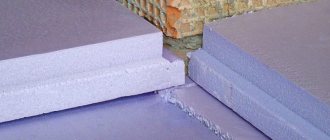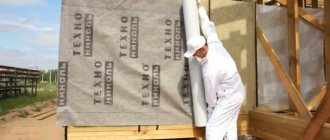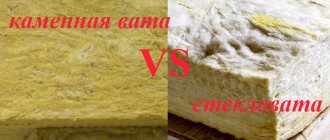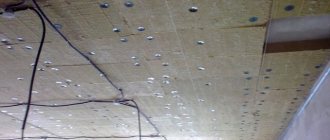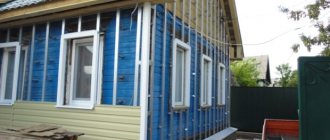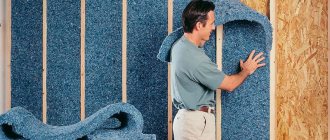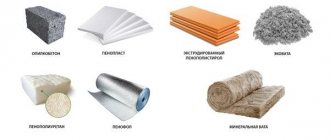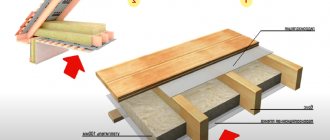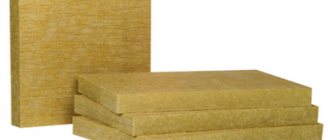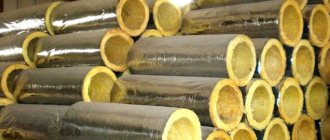In Russia, at least 5 months a year (in the northern regions - all
 There is a heating system in every living area of the house. And in the open air at this time there is a noticeable cold. And, if we are talking about the attic, which has the largest area of contact with the open atmosphere, then you should take this seriously. After all, in winter there is a serious temperature difference on both sides of the roof and the gables of the attic, which is why the heat flow always moves towards the source of the cold - out. And the task of insulating the attic is to stop this flow and minimize heat loss, for which purpose materials with low thermal conductivity are used.
There is a heating system in every living area of the house. And in the open air at this time there is a noticeable cold. And, if we are talking about the attic, which has the largest area of contact with the open atmosphere, then you should take this seriously. After all, in winter there is a serious temperature difference on both sides of the roof and the gables of the attic, which is why the heat flow always moves towards the source of the cold - out. And the task of insulating the attic is to stop this flow and minimize heat loss, for which purpose materials with low thermal conductivity are used. First of all, it is important to decide which insulation is best for the attic - based on the materials of manufacture, planned operation and expected internal temperature. Let's try to figure it out.
Styrofoam
Foam plastic is a modern thermal insulation material based on polystyrene foam.
Its structure is hardened polystyrene foam, inside of which there are many air bubbles. The advantages of polystyrene foam are light weight, excellent thermal insulation characteristics, low hygroscopicity and good sound insulation properties, which, combined with an affordable cost, make it one of the most preferred materials for insulation. At the same time, the disadvantages of polystyrene foam, which should be taken into account when arranging an attic, are flammability, instability to high temperatures and ultraviolet rays, as well as low strength.
To improve performance characteristics, some manufacturers treat foam products with fire retardants, which increases their service life by several years, which makes attic insulation with foam economically profitable.
It should also be said about what layer of insulation is needed for the attic if this material is used. The required thickness for most climatic zones is 15-20 centimeters, but in frosty regions it makes sense to increase it to 25-30 centimeters.
When arranging thermal insulation for an attic roof made of foam, it is important to ensure good ventilation of the under-roof space, since this material is not “breathable”. Otherwise, this may lead to condensation, mold and putrefactive processes.
How to insulate the roof of a private house from the inside?
In addition to mandatory compliance with fire and sanitary safety standards, strict and often contradictory requirements are put forward for the material, including:
- Thermal conductivity within 0.05 W/m²∙°С combined with low weight.
- The ability to allow free passage of air coupled with the lowest possible water absorption. Attic insulation must have hydrophobic properties or not absorb moisture at all.
- Durability. For insulators hidden in the thickness of the roofing pie, this indicator must correspond to the service life of the frame and other layers. Ideal insulation does not lose its properties after accidental wetting and retains its shape under other external influences.
- Easy installation , including on inclined surfaces.
- Noise absorption. This indicator is especially important when covering the attic with sheet metal (metal tiles, seams, corrugated sheets); materials with low soundproofing properties do not protect the premises from the noise of rain.
- Reasonable cost , possibility of self-installation.
Optimal results are achieved when insulating the attic with materials with a cellular (PUF, expanded polystyrene) or fibrous (all types of mineral wool, ecowool, eco-insulators) structure, combining low weight and versatility with good insulating properties.
It is worth noting that in practice, none of the proposed materials meets 100% of all requirements.
Read in detail about what materials are suitable for insulating a pitched roof and how to do it yourself, and from this article you will learn how to equip a warm attic under such a roof.
Required Density
This indicator differs for different materials and has a direct impact on the total load on the roof.
The use of grades with a minimum density is not always recommended , in the case of cellular types - due to deterioration of the structure and increased flammability, fibrous - due to the risks of caking, weathering or loss of shape.
Regarding mineral wool, the recommended density range varies from 40-80 kg/m³ with an optimum of 50-55, foam plastic - 30, expanded polystyrene - 30-35, polyurethane foam - from 45, ecowool - 45-60.
What is more convenient for do-it-yourself insulation: rolls or slabs?
Most types of attic insulation are sold in the form of long rolled mats or slabs of different formats. In any case, the width of the material is selected to match the size of the rafters, and the shape is selected for reasons of convenience. At the same time, roll varieties benefit from reducing the number of joints, speed and ease of installation. But these same types are more difficult to trim if the sizes and pitches of the rafters do not match (what are the features of the construction of the rafter system of an attic roof).
Relatively small slabs are easier to lift up and lay alone, including in the absence of floors or wide scaffolding, a complex roof configuration or a large number of windows and passage elements.
The problem of joints is solved by installing insulation in 2-3 rows, with the slabs offset. But for obvious reasons, their installation takes a little longer, especially with a complex installation pattern.
Important : in addition to ease of installation, when choosing the form of insulation, the possibility of its independent transportation and the need for acclimatization are assessed.
Rolled mats are most often sold in compacted form and need to be straightened before installation. The slabs are unpacked only for the purpose of temperature and humidity acclimatization and are generally used without delay. Requirements for the preparation of insulation are always indicated in the instructions and are clarified in advance.
Which roll material or mats to choose?
When choosing insulation for the attic, the question may arise: is it better to use rolled material or slabs? In this case, the answer will be individual for everyone, since everyone has different preferences.
Practical experience shows that material in rolls is more convenient to use. Simply roll out the roll to the desired length and cut off a piece. In addition, when insulating a roof that has a standard distance between the rafters, you can easily cut the material in half and fill the free space with them.
In the case of insulation boards, the advantage is convenient transportation. However, practical application is more problematic since the slabs are rectangular in shape.
In conclusion, it should be recalled that when buying insulation for the attic, it is very important to pay attention to the packaging. There should be no scratches or damage on it that indicate a leak. Only in this case is protection against moisture ingress into the insulation guaranteed before installation work begins.
Moisture that gets onto the material through poor-quality packaging leads to the insulation getting wet and changing its shape. As a result, installation becomes difficult in many ways, and gaps form between the slabs. In addition, damp material becomes a favorable environment for the growth of mold and mildew, which spoil the appearance of the surface and become a source of unpleasant odors.
Only in this case is protection against moisture getting into the insulation guaranteed before installation work begins. Moisture that gets onto the material through poor-quality packaging leads to the insulation getting wet and changing its shape. As a result, installation becomes difficult in many ways, and gaps form between the slabs. In addition, damp material becomes a favorable environment for the growth of mold and mildew, which spoil the appearance of the surface and become a source of unpleasant odors.
The best insulation for a pitched roof
Additional insulation of the attic floor is not always possible due to the low load-bearing capacity of the ceiling. In this situation, pitched roof insulation is used, which is laid between the rafters on the sheathing. The material is subject to lower requirements for thermal conductivity and density. Cold attics and attics can be insulated with thermal insulation. The VyborExperta.ru project analyzed 9 types of insulation from popular brands and chose 3 brands that attracted attention due to their price, simple installation and stable characteristics.
Rockwool Light Butts Extra
Stone wool slabs with a density of 40-50 kg/cub.m. Thermal conductivity of 0.038 W/(m*K) allows you to maintain a comfortable microclimate in the house in winter at minimal cost. A universal material used not only for insulating slopes, but also partitions, floors with joists, and other non-load-bearing structures. Has high linear tensile strength.
Advantages:
- Refers to non-combustible materials;
- High strength allows installation in vertical frames up to 6 m high;
- Reliable fixation between rafters;
- Good resistance to wind loads.
- Long service life.
Flaws:
- Not found.
Isover C-000176898
Rolled roof insulation made of mineral wool based on limestone and quartz. Density 15 kg/cub.m. allows you to reduce the load on the rafters and supporting structures. The roll rolls out easily, which has a positive effect on the speed of installation work. The packaging has markings for easy cutting to size. The thickness of 150 mm and the long length of the roll reduces the risk of heat loss through the joints. The thermal conductivity coefficient of 0.037 W/(m*K) provides a high level of thermal insulation.
Advantages:
- Improved water resistance;
- Elastic insulation does not require additional fasteners;
- Environmentally friendly material;
- Does not burn, does not lose its properties at high temperatures;
- Allows you to reduce the amount of insulation waste.
Flaws:
- Noticeable level of dust during operation.
The insulation format allows the material to be used when insulating roofs with different rafter pitches. This is relevant for restoration work and major repairs of old houses.
HeatKnauf TR 037 Aquastatik
Professional roof insulation for a private house with high hydrophobic characteristics. Aquastatik technology effectively protects against water. A universal material for vertical and horizontal structures in which the load on the insulator is not provided. Thermal conductivity of 0.037 W/(m*K) allows you to reduce heating and air conditioning costs. High air flow resistance increases service life. It has a low content of phenol-formaldehyde resins.
Advantages:
- Environmentally friendly material;
- High elasticity simplifies installation work;
- Low percentage of waste;
- Light weight;
- Good vapor permeability;
- No unpleasant odors.
Flaws:
- Requires caution when slicing.
Mineral wool density and thickness of mineral wool
Mineral wool is perhaps the most common insulation material for attic roofs due to its low cost and good thermal insulation qualities. In addition, the advantages of this material are also fire resistance, good breathability and low hygroscopicity. On the other hand, the thermal insulation characteristics of mineral wool are significantly reduced when wet, which makes it mandatory to equip it with waterproofing and vapor barrier membranes.
Mineral wool has several varieties:
- glass wool;
- slag;
- basalt or stone wool.
Glass wool is made from the finest glass fibers 5-15 microns thick and 15-50 millimeters long.
It has an elastic and durable structure, and requires great care when working: to avoid irritation, when laying it, wear a protective suit, gloves, goggles and a respirator. Resistant to temperatures from minus 60 to plus 450-500 °C
Slag wool, made from blast furnace slag, contains fibers 4-12 microns thick and approximately 16 millimeters long. This material can withstand heating up to 300 °C, but is ineffective when arranging thermal insulation of the attic due to its high hygroscopicity. In addition, slags with residual acidity can have an aggressive effect on metal surfaces, which is also a significant disadvantage. The disadvantages of slag wool are also its fragility and “prickliness”, which creates inconvenience when working with it with bare hands.
Basalt (stone) wool is made from gabbro-basalt or diabase with composite and binder additives. Its fibers are approximately the same size as those of slag wool. In terms of technological characteristics, this material is superior to all other types of mineral wool, and therefore is especially often used for thermal insulation of attic roofs. Stable when heated up to 600 °C (some types - up to 1000 °C). When using this type, the elasticity and density of mineral wool for attic insulation are sufficient so that the material does not wrinkle or settle when installed on slopes.
As for the required thickness of mineral wool for insulating an attic, it largely depends on climatic conditions, averaging 15-30 centimeters. It is clear that in regions with colder and more humid climates, the thickness of the insulation for the attic roof should be relatively greater.
Rating of roof insulation
The traditional technology for thermal insulation of attic floors of the second half of the twentieth century is backfilling with a layer of expanded clay or sawdust. The effectiveness of these materials is low, which often led to the appearance of frost and icicles on the inside of the slopes. In the spring, frozen condensation melts, the wood becomes damp and this reduces the service life of the rafters. To prevent this from happening, a more advanced insulation was required.
Architects designing houses with mansard roofs have also made new demands on thermal insulation materials. The popularity of these structures is due to the reduction in costs of building a cottage and the opportunity to get additional usable space instead of a cold attic. Insulation for an attic roof must differ in its technical characteristics from the materials used to insulate the attic floor or the used flat roof.
The variety of requirements for thermal insulators has led to the emergence of products with very different properties. Our Vyborexperta.ru team decided to weed out low-quality materials and understand the question of which roof insulation is best to use for different roof designs. To be included in our rating, products must have the best technical parameters. Performance characteristics, installation features, and cost were analyzed. Feedback from property owners and expert opinions were taken into account, and professional testing was performed.
Experts analyzed:
- Thermal conductivity - the lower the indicator, the less insulation thickness is required for effective insulation against heat loss;
- Density - low characteristics reduce the weight of the insulator and the load on rafters and supporting structures, but loose material tends to caking and losing its properties. A dense insulator retains its shape and thermal parameters well, but increases the pressure on the walls and foundation. We chose a compromise solution;
- Hygroscopicity - the ability to absorb moisture leads to a decrease in thermal conductivity.
- Thermal stability - the thermal insulator must maintain performance characteristics over a wide temperature range.
- Fire resistance - the flammability of the material, resistance to ignition and ability to support combustion were taken into account;
- Durability - the thermal insulation “pie” is subject to biological, chemical, and static effects;
- Environmental friendliness – the emission of harmful substances into the air is not allowed;
- Installation technology – affects the cost of insulation work;
- Price – when insulating, a large volume of materials is used; high cost can lead to a sharp increase in the estimate.
Not all analyzed insulation materials were suitable for effective thermal insulation of roof slopes or flat roofs. Complex installation, delamination, low biological stability, high fire hazard - materials with these characteristics were excluded from the rating.
Polymer thermal insulation materials
If there is no waterproofing film or diffusion membrane that protects the rafters from moisture accumulation during steam condensation, it is best to choose one of the polymer insulation materials.
Most often, a similar situation arises during the construction of a house in which a residential attic was not intended. That is why materials with extremely low permeability, such as polyurethane foams and expanded polystyrene, become the best option.
Such insulation perfectly protects not only from freezing of the structure or a decrease in room temperature, but also from constant exposure to moisture. They are harmless to humans, but require the creation of ventilation systems, as they interfere with normal air circulation.
Polyurethane foams
An interesting option for roof insulation is a material based on polyurethane foam. This insulation is applied by spraying, which ensures the absolute integrity of its layer without the formation of cold bridges.
In addition, this material does not require additional fastenings or fixation due to good adhesion to the base. To treat a roof of 100 square meters it will take no more than 4 to 8 hours, which significantly reduces the process of arranging the attic floor.
The thickness of such insulation to protect the attic compared to classic mineral wool can be reduced by 1.5 - 2 times and amounts to 80 - 100 mm. It is thanks to the integral structure of the applied layer, as well as the formation of absolutely closed air cavities, that polyurethane foam perfectly protects the room from heat loss.
Expanded polystyrene
In this case, both classic polystyrene foam and extruded polystyrene foam will cope perfectly with the task of insulation.
Both materials have excellent thermal insulation properties, but the extruded version is more reliable and durable. Its thermal conductivity is lower, so the effective layer is reduced to 80 mm.
The cost of polystyrene foam is lower, but taking into account the difference in the required amount of materials, the total costs remain approximately equal. The undeniable advantage of extruded polystyrene foam over polystyrene foam is its non-flammability.
Extruded polystyrene foam, unlike polystyrene foam, is not susceptible to rodents; its structure simply does not allow them to create their nests in the thickness of the material. Nevertheless, polystyrene foam still remains one of the most popular insulation materials.
The density of both types of expanded polystyrene is also selected in the range of 30 – 50 kg/m3 to prevent the weight of the structure. They are fastened using special disc-shaped dowels with large polymer caps.
The best insulation for a flat roof
Thermal insulation for a flat roof must withstand high snow loads. Waterproofing materials are applied on top of the insulation; if defects appear in the membrane, the insulation should not absorb water. Extruded polystyrene foam and high-density stone wool meet these requirements. Our experts analyzed the products of 6 brands and chose 2 brands. These products comply with SNiPs and strict requirements for flat roofs in use.
Penoplex Comfort
Extruded polystyrene foam with high strength characteristics. At a density of 25 kg/sq.m. can withstand a load of several tons per square meter. Supplied in the form of slabs with grooved edges, which simplifies installation and reduces heat loss through gaps. It has low thermal conductivity - 0.033 W/(m*K), which makes it possible to reduce the thickness of the insulator layer. Maintains operating parameters over a wide temperature range.
Advantages:
- Water absorption does not exceed 0.4%, which is 3-4 times lower than that of clinker bricks;
- Non-flammable material;
- Low load on supporting structures;
- Long service life;
- Can be used on existing and green roofs.
Flaws:
- Overcharge.
Extruded polystyrene foam was developed as insulation for submarines. The material does not lose its properties even when directly exposed to moisture.
TechnoNIKOL Carbon Eco
Extruded polystyrene foam boards with a density of 26 kg/sq.m. They have high bending strength and can withstand increased loads. Operation is allowed at temperatures from -70 to +70 degrees. Thermal conductivity of 0.034 W/(m*K) makes it possible to reduce the thickness of the insulation compared to using stone wool. It does not lose its properties under load and can be used to insulate existing roofs.
Advantages:
- Easy installation;
- No shrinkage;
- Does not attract rodents and birds;
- Durability;
- Low price.
Flaws:
- Low resistance to ultraviolet radiation.
Material requirements
Requirements for insulation materials may differ depending on the type of roofing device, but the basic characteristics must remain unchanged:
- thermal conductivity no more than 0.045 W/mK;
- material density in the range of 30 – 50 kg per cubic meter;
- rigid or semi-rigid structure of the heat insulator.
Thickness
The thickness of the insulation layer directly depends on the purpose of the attic floor. When installing living rooms and a bathroom within this space, it is necessary to protect the structure as much as possible from heat loss and freezing.
That is why experts advise using a layer of insulation of at least 100 - 150 mm. Moreover, the material is laid in 2 layers for more effective protection against heat loss.
Density
It is also worth remembering that the lower the density of the material, the greater its thermal insulation ability and the less impact on the rafter system. We must not forget that making the roof heavier can negatively affect the condition of the entire structure of the house, because the pressure of the rafters on the walls increases, and this can lead to their deformation.
That is why, before choosing the optimal insulation for the attic, you need to carefully study its properties and calculate the approximate load on the rafter system.
The best insulation for an attic roof
There are increased requirements for the thermal insulation of attic roofs. The slopes act as external enclosing structures and must ensure minimal heat loss. Installation of insulation when arranging an attic is often carried out from the inside, for example, if you want to turn the attic into a full-fledged living space. Insulation should not be difficult. We analyzed the products of 8 brands and settled on three that had good thermal characteristics and easy installation.
Isorok Ultralight P-33
The slabs are made from cotton wool, the threads of which are obtained as a result of the melting of basalt rocks. This is an environmentally friendly material with good vapor permeability. Using Isorok Ultralight will help create a cozy microclimate in the attic.
Density 33 kg/cub.m. allows you to reduce the load on rafter structures. Recommended for insulating non-load-bearing structures located on a slope. A slight static load does not lead to mineral wool caking and a decrease in thermal conductivity.
Advantages:
- Low thermal conductivity – 0.038 W/(m*K);
- High elasticity simplifies the installation of slabs between rafters;
- Mineral wool does not burn, retains its properties at a temperature of 600-650 ºС;
- Not subject to biological effects;
- Resistant to aggressive substances;
- Low price.
Flaws:
- Fiber delamination.
The developers reduced the water absorption coefficient to 1% by treating the fibers with compounds and water-repellent properties. This allows you to maintain performance characteristics throughout the entire service life.
Rockwool Light Butts Scandic
The slabs are made of basalt wool. Density 35 kg/cub.m. allows you to reduce the load on supporting structures. Treatment of mineral fibers with a water repellent reduced the water absorption coefficient to 1-1.5%. Thermal conductivity of 0.036 W/(m*K) allows you to reduce the thickness of the slabs used when insulating the attic. The insulation is easily cut with a stationery or construction knife, which simplifies installation work.
Advantages:
- One of the edges is flexible, which allows the insulation to be compressed when installed in a spacer;
- Compression is used during packaging;
- Service life – 100 years;
- Non-flammable material.
Flaws:
- It crumbles during installation.
- High price.
Paroc eXtra
The slabs are made of stone wool. The thickness of 100 mm allows you to increase the pace of installation work. Density – 30 kg/cub.m. reduces the load on supporting structures and foundations. Thermal conductivity 0.040 W/(m*K) meets the requirements for regions with cold climates.
Advantages:
- Good vapor permeability;
- High fire retardant characteristics;
- Provides effective sound insulation of the attic;
- Low water absorption – 1%.
Flaws:
- Low density leads to delamination.
Sawdust
Insulating the attic roof with sawdust is not recommended due to the low performance characteristics of this material. The only advantage is the price. According to other criteria, sawdust is inferior to modern insulation.
- Relatively high thermal conductivity coefficient;
- Spontaneous changes in density under the influence of gravity, the likelihood of voids appearing in the roof structure;
- Combustible material. The effect is reduced when using a solution with gypsum, cement or lime;
- Rotten;
- Habitat for rodents and insects.
The best materials for insulating an attic are basalt wool and polyurethane foam. They have high thermal insulation properties, reduce noise levels and are harmless for use in residential areas.
How to calculate the thickness of thermal insulation
To calculate what layer of insulation will be needed to insulate the attic, builders use the formula from SNiP II-3–79 δut = (R - 0.16 - δ1/λ1 - δ2/λ2 - δi/λi) × λut, in which R is thermal resistance of a slope, wall or ceiling (m2×°C/W), δ is the calculated thickness of individual structural elements in meters, and λ is the thermal conductivity coefficient of insulation (W/m×°C) for the structural layers used.
In private house building, the formula is simplified to a simple equation δut = R × λB, where the last factor characterizes the thermal conductivity of the insulation used in W/m×°C. The minimum thermal resistance of walls, roofs and ceilings depends on the region in which construction is being carried out.
Table: thermal resistance values depending on the region of construction
| City | R (m2×°C/W) | ||
| For floors | For walls | For coatings | |
| Anadyr | 6,39 | 4,89 | 7,19 |
| Biysk | 4,65 | 3,55 | 5,25 |
| Bryansk | 3,92 | 2,97 | 4,45 |
| Velikiy Novgorod | 4,04 | 3,06 | 4,58 |
| Derbent | 2,91 | 2,19 | 3,33 |
| Ekaterinburg | 4,6 | 3,5 | 5,19 |
| Irkutsk | 4,94 | 3,76 | 5,58 |
| Kaliningrad | 3,58 | 2,71 | 2,08 |
| Krasnoyarsk | 4,71 | 3,59 | 5,33 |
| Maykop | 3,1 | 2,8 | 3,5 |
| Moscow | 4,15 | 3,15 | 4,7 |
| Murmansk | 4,82 | 3,68 | 5,45 |
| Nalchik | 3,7 | 2,8 | 4,2 |
| Naryan-Mar | 5,28 | 4,03 | 5,96 |
| Nizhny Tagil | 4,7 | 3,56 | 5,3 |
| Omsk | 4,83 | 3,68 | 5,45 |
| Orenburg | 4,49 | 3,41 | 5,08 |
| Permian | 5,08 | 3,41 | 4,49 |
| Penza | 4,15 | 3,15 | 4,7 |
| Saint Petersburg | 4,04 | 3,06 | 4,58 |
| Saratov | 4,15 | 3,15 | 4,7 |
| Sochi | 2,6 | 1,83 | 2,95 |
| Surgut | 5,28 | 4,03 | 5,95 |
| Tomsk | 4,83 | 3,68 | 5,45 |
| Tyumen | 4,6 | 3,5 | 5,2 |
| Ulan-Ude | 5,05 | 3,85 | 5,7 |
| Chelyabinsk | 4,49 | 3,41 | 5,08 |
| Chita | 5,27 | 4,02 | 5,9 |
The thermal conductivity characteristics of any thermal insulation material can also be found in the tables.
Table: thermal conductivity coefficients of materials
| Material | λ (W/m×°С) |
| Foam rubber (polyurethane foam) | 0,03 |
| Penoizol | 0,033 |
| Expanded polystyrene | 0,04 |
| Basalt (stone) wool | 0,045 |
| Glass wool | 0,05 |
To determine the thickness of the insulation, it is not at all necessary to count everything manually. You can use an online calculator, which is easy to find on the Internet. All that is needed in this case is to enter the values of the climate zone, the area of the attic, the type of insulation and its scope. The program will do all other calculations for you.
Performance characteristics of fiber insulation
Glass wool
.
Her positive qualities include
:
- fire safety (2nd degree of fire resistance);
- environmental safety (does not contain resins);
- unattractive to mice (they do not build nests and passages);
- affordable price.
The main disadvantage is that when working with the material, caustic glass dust is formed; installation of the heat insulator requires care and the use of protective equipment
. In addition, over time, glass wool tends to deform and wrinkle, especially when moisture penetrates.
Mineral wool
. The material contains fibers of various origins (manufacturing materials - clay, stone, quartz sand, glass, etc.). Mineral wool is characterized by a multilayer heterogeneous structure with air lenses. Due to this, the material dampens sound waves well. Choosing mineral wool (primarily Isover, Ursa) is recommended for those who have decided to make metal roofing.
This heat insulator is fire-resistant, does not rot, and is easy to install. But rodents can settle in it, whose nests, passages and waste products reduce the performance properties of the insulation.
Basalt wool
. Consists of fibers obtained by melting rock. Withstands heat up to 1000 degrees, does not spread combustion. You should choose basalt wool carefully, checking quality and safety certificates: some manufacturers, in an effort to reduce the cost of products, use resins that emit toxic substances.
Basalt wool
Basalt wool is resistant to fungus, but can be damaged by rodents. This is a good sound insulator and easy to install. But when choosing a material for insulating a rafter system, you should take into account the fairly large weight of stone wool slabs.
If you have to choose a fiber insulator for attic insulation, pay attention to the density of the material. The heat insulator should not lose its shape even after prolonged use.
For mineral, basalt wool, the density indicator should be about 40-45 kg/m3.
Polymer materials for insulation
We choose a polymer heat insulator for the roof and walls of the attic. This can be polystyrene foam, extruded polystyrene foam (these two types of insulation are available in the form of sheets and slabs of various thicknesses), as well as polyurethane foam, which is applied to structures by spraying.
The advantages of polymer insulation include low weight and low thermal conductivity. Such thermal insulation will not overload the rafter system and will successfully cope with the task of retaining heat.
The disadvantages of polymer insulation include extremely low vapor permeability. There is no gas exchange through insulated structures, so you cannot do without a well-thought-out ventilation system in the attic.
Insulation of the attic with polyurethane foam
Thermal insulation made of extruded polystyrene foam (penoplex) and polyurethane foam will not allow heat and steam to pass through to the roof rafter frame, therefore, there is no need to install a vapor barrier on the room side. Despite the fact that the dew point during internal insulation of gables will shift towards the heat insulator, moisture, dangerous for wood, will not condense.
Manufacturers produce penoplex of various densities. For pitched roofs and attic walls, where heat loss is high, it is advisable to use slabs with a density of 30-35 kg/m3.
A suitable foam density is 35 kg/m3; at a break, the material should not crumble into individual balls
. Since polystyrene foam smolders when ignited, releasing toxic substances and is easily chewed by mice, it is not the best material for internal insulation.
Polymer insulation for the attic should not be considered as a soundproofing material for the roof - it will not save you from the sound of raindrops. But if you insulate the floor with it, it will reduce the vibration load from steps, creating acoustic comfort in the rooms under the attic.
The selected insulation option will last for many years if you purchase good material and take into account all the details of its installation.
An insulated attic is a room that will definitely come in handy
No matter how large the house is, an additional living room is always useful - it can be used as a guest bedroom, a small gym or a spacious storage room. In accordance with regulatory documents, an attic is a room that is formed by a roofing deck or the facade of a building. And sanitary standards clearly say: the height from floor to ceiling should be at least 250 cm, and to the line where the roof intersects the wall - 150 cm . Moreover, a “high” ceiling (from 250 cm) must be at least 50 percent of the entire area of the attic space.
Note! It is no secret that when building private houses, people often deviate from these standards. For example, if the roof is raised high, the attic ceilings will be higher, but the area of the floor itself will be significantly reduced.
Layers of the attic pie
There are various methods for increasing the area of the attic space: increasing the height of the facade walls, the lower part of the sloping roof, etc. But, despite all the advantages of the attic, there are certain factors that increase the cost of construction/finishing:
- heat and waterproofing;
- window installation;
- arrangement of the ventilation system.
The first point is especially important, since literally everything is subject to insulation (from walls to gables). Therefore, special attention should be paid to the choice of insulation. The material must not only have the appropriate technical characteristics, but also be completely safe.
Types of insulation materials
Choice of thermal insulation
The design of the attic roof has the following features that you need to focus on when choosing material for its insulation:
- Lightweight materials should be used as roofing and insulation for the attic roof, since its design is not designed for increased load.
- To insulate the attic roof, the most effective materials should be used so that the thickness of the roofing layer is minimal - this will also help reduce the weight of the roofing structure.
- It is necessary to install a ventilation system for the roof space to control the humidity in the room.
Mineral wool
Mineral wool is often used to insulate attic roofs. Its advantages:
- Light weight.
- High thermal insulation qualities.
- Good vapor permeability and sound insulation.
- Environmental friendliness and fire safety.
The amount of insulation corresponds to the area of the roof slopes minus the area of the openings
Among the disadvantages of such thermal insulation of the attic roof are the relatively high price and the tendency to get wet. In addition, mineral wool can cake and lose its properties over time.
Important: For roof insulation (sloping and vertical surfaces), it is better to use mineral wool in slabs rather than rolls - this will make installation easier.
You can also use glass wool to insulate the attic roof, but it is less convenient to use and requires protective equipment: gloves, overalls and glasses.
In cold regions, the thickness of such thermal insulation should be 150-200 mm - this can be achieved by laying mineral wool slabs in two layers. When installing external insulation, work on installing the material should be carried out only in dry weather.
Polystyrene foam or polystyrene foam
Insulation of attic roofs with foam plastic is common due to its low cost. Among the advantages:
- Little weight.
- Low thermal conductivity.
- Easy to process and install.
- Good performance.
- Does not deform.
- Not afraid of moisture.
How to insulate an attic roof with foam plastic
Insulating an attic roof with foam plastic has a significant drawback - a fire hazard. But you can use extruded polystyrenes, which do not burn, but only melt, but their cost is much higher.
Polyurethane foam (PPU)
New effective material for insulating attic roofs. In essence, it is a modified polyurethane foam. PPU can only be used to insulate an attic roof from the inside, a video with application technology is at the end of the article, but at the same time:
- The thickness of the insulation layer is minimal.
- Polyurethane foam has good adhesion, and when applied, fills all voids in structures.
- It is simultaneously a heat, hydro and vapor barrier.
Insulation using polyurethane foam
Spraying polyurethane foam requires special skills and equipment, but there will be no seams at all, which will prevent freezing of structural elements.
When choosing the best way to insulate an attic roof, you can also focus on a material such as ecowool. This natural insulation (made from flax) will not only protect from the cold, but also from overheating in the heat, it is breathable and environmentally friendly. Ecowool provides a seamless coating and does not require a vapor barrier. Suitable, for example, for insulating a sloping attic roof due to simple installation on inclined surfaces.
Cold attic or attic: the main difference
In non-residential attic spaces, thermal insulation is laid in the niches between the ceiling beams. In this case, the roof structure plays the role of a barrier that protects the building from wind load, temperature expansion and precipitation. Insulation for an attic roof, on the contrary, is part of a roofing sandwich designed to simultaneously perform all the functions inherent in the walls, ceiling and roof.
Classic roofing scheme for the attic
More moisture enters the attic than the floor spaces. Water penetrates from below in the form of rising vapor. Vapor barrier of the floor ceiling reduces the flow of moisture, but does not eliminate it.
The second factor in air humidification is associated with the inevitable condensation on the lower surface of the tiles or other roofing material. Moreover, the amount of this condensate on insulated roofs is greater than on cold roofs due to the increased temperature gradient. In addition, a ventilated cold attic forms a buffer air cushion, effectively drying the roof from below. The absence of such a buffer in attics reduces the natural ventilation of wooden rafters and the insulation itself.
Schematic diagram of the operation of an attic roofing pie
Placing thermal insulation directly under the roof slopes increases the rate of heat transfer, so insulation for the attic should be more energy efficient than insulating the floor between the dwelling and the cold attic.
A little about the types of insulation
Next, we will look at insulation materials suitable for insulating the attic floor, its gables and roof. There are a great variety of materials offered to us in stores, and they all have different physical and technical characteristics. Let's figure out which insulation is better for the attic.
Mineral wool
The most popular material for insulating the attic floor is produced by different companies - Rockwool, Ursa, etc. Mineral wool has low thermal conductivity and absorbs sound well. It is worth mentioning the fire safety of the material: slag wool begins to smolder at 300C°, stone wool at 600C°, and basalt wool in general only at 1000C°. Mineral wool has only one significant disadvantage: it gets wet.
It is produced both in rolls - soft, and in slabs - more rigid, with a higher density. If the attic has a ceiling, we “insulate” it with rolled rockwool or similar mineral wool from another company. For gables, slab types of mineral wool are better suited: roll types, due to their softness, when installed on a vertical surface, will sag over time.
The best way to insulate an attic from the inside: mineral wool
Insulation of the attic floor with penofol
The material has good thermal insulation qualities, but insulation with penofol as an independent material is impossible, it is too thin. But it can be used as additional insulation and a replacement for vapor barrier, although due to its vapor resistance it requires good ventilation.
How to properly insulate an attic from the inside: penofol is suitable only as a vapor barrier
Penoplex and polystyrene foam for insulating the attic floor
Penoplex and polystyrene are both derivatives of polystyrene. Reviews about attic insulation with polystyrene foam are generally not bad. The same applies to penoplex. Both materials retain heat well, almost do not absorb moisture and are very light in weight. In addition, insulation with extruded polystyrene foam is quite cheap.
Insulating an attic with a simple roof with polystyrene foam is possible, but with a broken one you will have to tinker. No matter how precisely you cut the slabs of material, it will not fit 100% tightly to the roof structures, but our gables are adjacent to it. And foaming of cracks, which is usually used in such cases, cannot be used here.
How to insulate an attic floor: penoplex and polystyrene foam
An interesting way to insulate an attic with polystyrene foam: video of filling polystyrene foam granules under the film.
Sawdust and ecowool
Sawdust is the cheapest and most environmentally friendly material of all. The use of the material as insulation began a very long time ago; this is, so to speak, an old-fashioned way. Sawdust has good thermal insulation properties and will also protect against noise. However, the material is susceptible to fungal and putrefactive infections, easily absorbs water, and over time the sawdust cakes. They are not suitable for insulating the attic roof and its gables, but the material can be used for the floor.
Insulating the attic from the inside with your own hands: sawdust
Ecowool is probably not inferior to sawdust in terms of environmental friendliness. But in terms of technical qualities, it is much better. Ecowool does not cake, does not rot and is not affected by fungi. The quality of heat and sound insulation is excellent, suitable for installation on all surfaces. But you won’t be able to insulate an attic with ecowool yourself—the technology requires special equipment.
Insulation of the attic gable: dry blowing of ecowool under the vapor barrier membrane
Ecowool for attic insulation. Video of wet application of material.
Insulation of the attic floor with polyurethane foam
Reviews about attic insulation with polyurethane foam are, for the most part, very good. It is universal in use, equally suitable for insulating gables and ceilings, as well as for attic roofs. The material does not settle, does not absorb water, and during its installation there will be no cracks or joints, which means there will be no heat loss associated with them. Insulating an attic using polyurethane foam is done very quickly, however, as in the case of ecowool, polyurethane foam is applied to the surface using a special apparatus.
Which insulation to choose for the attic: polyurethane will be an excellent option, but you will have to call specialists to carry out the work.
How to properly insulate an attic: video of the polyurethane foam spraying process.
https://youtube.com/watch?v=DUFV8okh_xw
Video description
The insulation of an ecowool frame house is shown in this video:
The wet application process begins with fixing the vapor barrier film, in which holes are made. Through them, the necessary holes are filled with ecowool.
Insulation with polyurethane foam
To insulate an attic with polyurethane foam, you also need professional tools. The material can be sprayed onto any surface. The mass fills all the gaps without leaving seams.
Typically, polyurethane foam is applied to the inner surface of the roof, and the top is covered with decorative finishing. If the house is located in a temperate climate zone, then such a layer of insulation will be sufficient.
Ecowool
Relatively recently, a new insulation material has appeared on the construction market - ecowool. For its production, waste newspapers are used, which are pre-shredded and treated with fire retardants and antiseptics. At the same time, dangerous lead, which, according to many, is contained in newspapers, is completely excluded from ecowool.
The composition of the material fully complies with environmental requirements, even during the smoldering process and with a sharp change in temperature. This property makes ecowool more effective and profitable compared to mineral wool and expanded polystyrene.
But due to insufficient knowledge, insulation with this material is carried out only by specialized construction organizations.
Natural wool
In some regions, natural wool or felt is used as roof insulation. These materials have good vapor permeability and excellent thermal insulation properties.
Wool can be used independently, but its use in a roofing pie is considered more effective.
For the Caucasian region, wool is the most affordable insulation material, which gives a great advantage over ready-made, more expensive materials. But in this case, do not forget about insects and rodents that can live in natural material.
How does heat exchange occur in the attic?
Work on insulating the attic began after the installation of the heating system in the attic, because such materials allow you to retain warm air in the middle of the house. In the absence of a heating system, laying thermal insulation does not always give the desired effect. The heat here is retained by a small air gap, which is located between the ceiling and the roof; this is also facilitated by a layer of snow on the roof.
When installing a heating system on the attic floors, the heated air will tend to rise, it will quickly heat the roof and melt the snow. To reduce energy losses, the owner of the house must provide insulation for the facade of the building. This work can be done using one of the methods described below:
1. Insulation of the roof of the house from the inside. In this case, it would be advisable to lay insulating mats in the space between the roof rafters. This method of reducing energy losses is considered one of the most expensive, but in some cases it is considered the only possible solution. Many people ask what is the best way to insulate an attic roof. One of the possible options is the installation of mineral wool with further installation of a vapor barrier film.
2. Another method of insulation is external thermal insulation. Experienced builders recommend this particular method, because when joining insulation boards, the possibility of the formation of cold bridges is reduced. It is advisable to carry out such work during the installation of the roof, in which case the thermal insulation materials are laid on a vapor barrier film. This element is fixed to the rafters using staplers. At the final stage of the work, the insulation is protected from moisture with a waterproofing film, the rolled products are fixed with the same stapler and installation of the roof covering begins.
If we compare internal and external insulation, the latter option has worse protection against precipitation. Materials for external insulation must hold their shape well and not allow moisture to pass through. For those who do not know what is the best way to insulate an attic roof from the outside, it is advisable to choose polystyrene foam.
Reviews
There is no consensus on the best type of insulation for such roofs, but most owners recommend insulating attic slopes with mineral wool with a density of 45-50 kg/m³ and a layer thickness of 200 mm.
The best reviews are from specialized roofing brands Rockwool and TechnoNIKOL . Among fiberglass-based roll materials, Ursa is rated positively.
In addition to brands, construction forums often discuss the permissibility of combining different materials (in particular, mineral wool and polystyrene foam or polystyrene foam) and the choice of the best materials for closing the insulating layer from the inside.
On the first question, there is again no general opinion, but most owners do not consider combining heat insulators a good solution (with the exception of heating zones and contact with chimneys). According to the second, plasterboard is recognized as the optimal material.
You can get acquainted with the opinions of builders about various insulation materials here, here and here.
Fiber roll and slab insulation
This category includes
:
- glass wool;
- mineral wool;
- stone (basalt) wool.
Their key advantage and at the same time disadvantage is the ability to pass steam. Theoretically, moist warm air from the attic will escape through the breathable interior lining, insulation and roofing system, which will help maintain a favorable indoor climate. In practice, the following difficulties exist
:
- an increase in the humidity of fiber insulation leads to a sharp decrease in its thermal insulation properties;
- insulation (especially glass wool) that has absorbed moisture becomes wrinkled and deformed, forming cold bridges;
- The wood of the rafter system begins to rot from contact with moisture.
To avoid these problems, it is necessary to install a vapor barrier on top of the insulation from inside the room. And between the roofing covering and the thermal insulation, a waterproofing material must be laid
.
Superdiffusion membrane
Why can't you insulate your roof?
Having told how to properly insulate a roof and with what, we can already remind you that it cannot be insulated. Forbidden, under no circumstances.
“This is news to me!” - write puzzled homeowners, when a consultant of our portal with the nickname Matilda once again patiently explains this “once again, for those who understand.”
The roof must remain cold.
Everyone knows that the roofs of low-rise buildings are insulated throughout the vast expanse of Russia, from Kaliningrad to Vladivostok, and that natural materials were used as thermal insulation in the homes of our ancestors.
But no, this is a mistake.
MatildaFORUMHOUSE Consultant
The roof must remain cold. Insulate the room. The phrase “insulate the roof” means laying insulation between the rafters, as close as possible to the roof covering. This is done to maximize the volume of the room.
And the roofing itself must remain cold! This means ventilation is necessary.
MatildaFORUMHOUSE Consultant
The air enters at the eaves into the cracks of the filing and exits at the ridge into special valves. In the place where the floor, walls and roof meet, make sure that there is a gap of at least 5 cm between the roof and the insulation for air passage.
After converting an attic into a warm attic, the humidity in the room can increase significantly. The air temperature in an unheated attic is almost the same as outside, there are no problems with condensation, so it is enough to insulate the ceiling well. In winter, it is much warmer in an insulated attic than outside, and most importantly, the air is more humid; moisture rises upward along with warm air, comes into contact with the colder surface of the roof - condensation forms. And this is not so bad - if the insulation layer is not laid well enough, then moisture penetrates into the roof structural elements, and they will not last long.
For most homeowners, this is “sudden”:
Urfene DjusForumHouse Member
They will wake up when the finish begins to get wet, and this will already have consequences.
Problems with condensation can also occur:
- Due to cracks or other defects in the roof structure (it is recommended to inspect them before insulation and, if possible, replace them);
- Due to poor-quality vapor barrier, or the absence of a vapor barrier layer in the roof pie;
- Due to problems with the attic ventilation system. We made repairs, installed plastic windows, moved or blocked ventilation holes, and voila - wet spots on the finish.
That’s why professional roofers attach such importance to vapor barriers, and on the roof side, the thermal insulation material is protected with a layer of waterproofing - this results in double protection. But even that is not enough.
Urfene DjusForumHouse Member
You will not prevent steam from penetrating into the cake one hundred percent, and humidification will occur at the dew point.
Without good ventilation, problems will still appear - the roofing gurus of our portal always insist that in a warm roof pie there are gaps for air circulation on both sides.
KabykiFORUMHOUSE Member
Finishing, gap 2 - 3cm, vapor barrier, insulation, vapor-permeable membrane, ventilation gap 50mm, step lathing, roofing.
And so that air can move freely through these gaps and remove moisture from the heat-insulating material, vents are made in the overhang and upper part of the roof, or the insulation is mounted up to the crossbars, leaving a cold triangle. This option is considered better than insulation up to the ridge, but only if the cold triangle is ventilated.
raf2603FORUMHOUSE Member
The cold triangle must be ventilated; for this purpose, ventilation grilles are made on the gables, as well as GI cuts on the ridge (but to prevent snow from sweeping under the ridge, you need to install an aero element or seal under the ridge).
Expanded polystyrene
Belongs to the group of rigid foam plastics. According to production technology, there are two types - pressed (PS) and pressless (PSB).
Thermal conductivity in dry form is almost the same as that of mineral wool. But in real operating conditions it’s a little lower. Therefore, it is usually noted that polystyrene foam has better thermal insulation properties.
One of the most inexpensive thermal insulation materials. Easy to install.
Low water absorption - from tenths of a percent to 2 - 4%. But it is capable of accumulating moisture, which, when frozen, destroys the fragile bonds between the individual “capsules” of the material.
The main disadvantage in operating conditions of an attic roof is low vapor permeability. When insulating in several layers, some of the wooden structural elements may end up between the insulation and the vapor barrier (for example, sheathing or counter-lattice). This can lead to the wood getting wet and the appearance of rot, which can already “infect” the supporting structure.
The second disadvantage is flammability. Although they produce “self-extinguishing” polystyrene foam PSB-S with fire retardant additives (it is a low-flammable material), it also emits toxic gases upon contact with fire.
Foam plastics are not noise-absorbing materials. Under certain conditions (as part of structures with thin-sheet cladding) they can even amplify noise at certain frequencies.
Criteria for selecting insulating material
What is the best way to insulate an attic? Studying the properties of thermal insulators cannot give a substantiated answer to this question. It is necessary to correlate the characteristics of materials with their operating conditions. The specificity of attics is expressed in three main rules for their insulation:
- Timeframe for completing thermal insulation work. Typically, freshly sawn wood is used for rafters. In this case, it is necessary to wait at least six months before insulation is carried out with materials with high vapor permeability. Even when using dried wood, a pause of at least 2 weeks is necessary after installing the roofing.
- Choice of insulation thickness. The intensity of heat flow through the roof is much greater than the energy lost through the walls or foundation. The usual thickness of mineral wool of 100 - 150 mm does not solve the problem of attic insulation even in the southern regions of Russia. It is necessary to use special calculator programs where climatic conditions, dimensions of building structures and materials of all layers of the sandwich are substituted. In conditions of a temperate continental climate, the required design thickness of the insulator for a mansard roof is almost never less than 300 mm.
- Design of rafter beams.
The height of the lumber profile should be 30 - 40 mm higher than the thickness of the thermal insulation layer. In this case, a sufficient ventilation gap is formed between the waterproofing and the insulation.
If work is underway to convert a cold attic into housing, then additional sheathing is usually used at the bottom of the rafters, increasing the installation height to accommodate the insulating layer.
Table of comparative characteristics of roofing insulation
To determine which insulation is best for your attic roof, make a comparative assessment of the materials, taking into account the three rules outlined in the following order:
- Eliminate options that do not meet your fire safety requirements.
- Eliminate options with high vapor permeability of insulation if you do not have time to dry the rafter wood.
- Calculate the required insulation layer thickness for several options.
- Create budget options. In this case, it is necessary to take into account the exclusion of a vapor barrier membrane from the sandwich composition in the case of using insulating materials with hygroscopicity close to zero.
Polyurethane foam
Spraying polyurethane foam is a good way to insulate an attic. In addition, the material has the following properties:
- Excellent degree of thermal protection.
- Possibility of insulation without a frame and special fastenings.
- The absence of seams, which are always conductors of cold.
- Creating tightness in hard-to-reach places.
- No reaction with any roofing material, excellent resistance to moisture and vapor permeability.
- Good grip on any surface.
- Polyurethane foam is not afraid of rodents and insects, and is also not affected by mold and rot.
But polyurethane foam still has a drawback: it cannot be applied independently without special equipment.
Basalt or stone wool
The most popular and safest type of mineral wool is basalt wool. This material is based on natural stone - basalt, which under high temperature is melted and stretched into thin fibers. Basalt wool can withstand heating up to 10,000C, but is not able to withstand rodents.
The most popular brand of stone wool, Rocklight, is characterized by its ability to retain heat, absorb excess noise, fire resistance and easy installation. At the same time, basalt insulation for the attic of sufficiently high quality can be purchased at a relatively low price.
Another advantage of the material is durability and the ability to “breathe” over a long period of use. The vapor permeability of the insulation is of great importance when finishing the attic, as it prevents the appearance of mold and various fungi.
The need for roof insulation
High-quality insulation of the roof of a private house reduces the percentage of heat loss inside it. An ideal temperature is formed, which is easy to regulate without significant losses in heating or cooling the air with electrical appliances.
Incorrectly selected thermal insulators lead to poor quality insulation of the roof of a private house. In winter, ice forms on it and icicles form. Icing can compromise the integrity of roofing elements by causing leaks.
A poor-quality insulating layer can lead to dampness in the roof space of a private house. High humidity leads to the spread of fungus and mold. The wooden truss structure suffers, which swells over time and becomes unusable.
Content
- What types of roof insulation are there?
- Basics Comparison Chart
- 2 best basalt insulation Hotrock Smart
- Rockwool
- Ursa Geo
- Knauf Therm House
- TechnoNikol XPS Technoplex
- Shelter EcoStroy ShES standard
- Moscow
Advice from professionals
It is optimal to lay expanded polystyrene slabs when the roof is still under construction. If the attic has already been built, mineral materials are used. A sheathing is created on the inside. Mineral wool is placed between the rafters and covered with cladding on top.
Roofing pie, where any type of mineral wool is used as insulation, includes protective membranes from moisture
The use of any wool requires the installation of vapor and waterproofing. Membranes protect thermal insulation from moisture. The roofing pie consists of the following layers:
- on the roofing side of the roof, waterproofing comes first;
- thermal insulation is laid as a second layer;
- third layer – vapor barrier;
- to form a ventilation gap and fasten the internal lining, a sheathing is assembled from slats;
- the last layer is the finishing layer.
The ventilation gap is left at least 3 cm. Any materials you like are used for finishing: lining, plywood, particle boards.
Comparison of the main characteristics of thermal insulators
| Insulation | Density kg/cub.m | Thermal conductivity W/(m*K) | Flammability |
| Minvata | 35 — 40 | 0,035 — 0,039 | NG |
| Glass wool | 15 — 20 | 0,035 — 0,042 | NG |
| Polyurethane foam | 60 — 80 | 0,023 — 0,032 | NG |
| Expanded clay | 300 — 500 | 0,09 — 0,1 | NG |
| Ecowool | 38 — 41 | 0,038 — 0,041 | G2 |
| Styrofoam | 10 — 37 | 0,033 — 0,041 | G1 |
| Extruded polystyrene foam | 26 — 32 | 0,028 — 0,031 | G4 |
| Sawdust | 0,10 — 0,25 | 0,07 — 0,09 | G3 |
